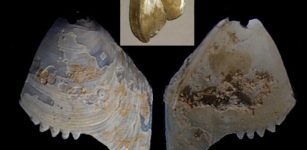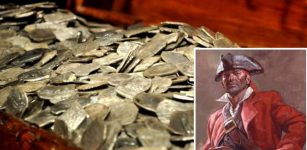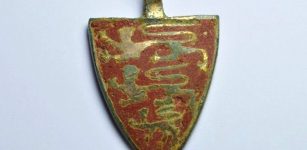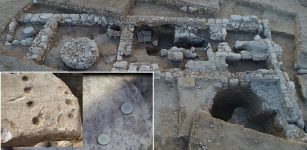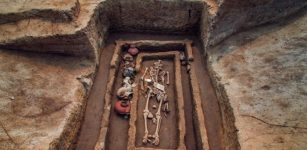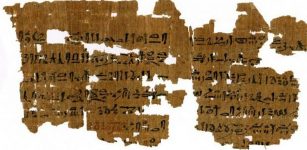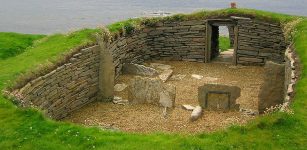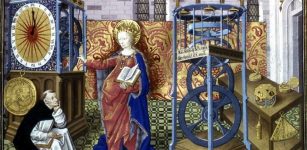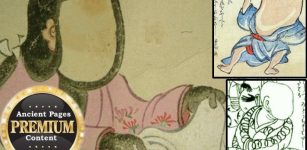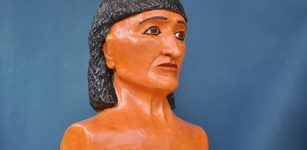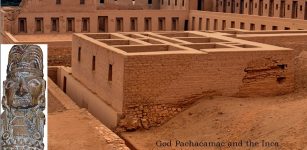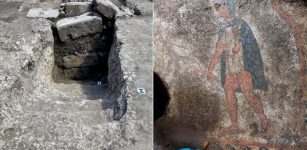New Paintings And Details Uncovered In The Egyptian Temple Of Esna
Conny Waters - AncientPages.com - The Roman-era temple of Esna, located 60 kilometers south of Luxor in Egypt, is currently undergoing significant restoration as part of a collaborative project between Egyptian and German teams.
The cartouches of Ptolemy VI on the Ptolemaic facade. In front of them, two forms of the local god Khnoum. At the top of the picture, modern spikes have been installed as protection against pigeons. Credit: University of Tübingen
Although the main structure of the temple no longer exists, its large vestibule or pronaos was rediscovered over two centuries ago and remains intact. The restoration efforts have been ongoing since 2018, with leadership from Hisham El-Leithy of the Ministry of Tourism and Antiquities (MoTA) Documentation Center on the Egyptian side, and Professor Christian Leitz from the Institute of Ancient Near Eastern Studies at the University of Tübingen on the German side.
Historically, local inhabitants used fires within this vestibule over a span of 1,800 years, which resulted in blackening its once-vibrant wall and column decorations.
Over the past six years, a dedicated team comprising up to 30 Egyptian restorers under Ahmed Emam's guidance has successfully uncovered these colors. Their work has revealed not only astronomical images adorning the entire ceiling but also restored the vivid hues on all 18 inner columns.
This year marked the beginning of a new phase in the restoration of the Esna temple. Specialists have successfully restored the southern inner wall and part of the western rear wall, revealing vibrant original colors dominated by yellow and red pigments. This color scheme contrasts sharply with those found at other sites, such as the temple of Dendera, where white and light blue are prevalent.
"The greatest discovery this year was the many painted details of the clothing on the king and the deities of Esna, their crowns and their thrones," says Christian Leitz. "Previously, we could not see them at all due to the thick layer of soot over the reliefs."
The holy barque with the shrine of Khnoum, the main deity of Esna, carried by several priests. Source
The painted details uncovered are integral to the offering scenes that adorn the temple's inner walls. While researchers were already aware of hieroglyphic texts and reliefs, these newly revealed decorations on throne images offer additional insights.
For instance, in one scene depicting an offering to goddess Neith, four painted bows were discovered on a throne—likely part of an original set of nine bows symbolizing Upper and Lower Egypt along with seven other territories under Egyptian rule.
Another notable detail is found on a king's apron in an offering scene. It features two plants: papyrus at the top, representing Lower Egypt, and lily at the bottom, symbolizing Upper Egypt, underscoring his dominion over both regions.
Perhaps most striking is a scene featuring Khnoum's holy barque carrying his shrine. This boat is depicted being carried by priests during processions for public viewing on special occasions; otherwise, it remained hidden within restricted temple areas accessible only to priests.
The king sacrificing four incense burners before Khnoum’s holy barque. In front of him is the sem-priest, wearing a leopard skin and making an offering of a potter’s wheel to the creator god Khnoum. Source
Restoration efforts will continue from November onwards with plans focused on cleaning six front columns' outer parts—a task unsuitable for summer due to extreme heat conditions. The project receives support from organizations like the Ancient Egypt Foundation, the American Research Center in Egypt, and the Gerda Henkel Foundation.
The local crocodile god Shemanefer with many fine details painted on his crown, wig, apron and throne. Source
The pronaos, measuring 37 meters in length, 20 meters in width, and reaching a height of 15 meters, was constructed from sandstone during or before the reign of Roman Emperor Claudius (41–54 AD).
See also: More Archaeology News
It likely surpassed the size of its main building and has been preserved amidst the city center's surroundings, avoiding the fate of quarrying that many ancient structures faced during industrialization throughout Egyptian history. This site attracted scholarly attention as early as Napoleon's visit due to its exemplary representation of traditional architectural styles characteristic of antiquity. Its significance within this locale is notable both historically and contextually.
Written by Conny Waters - AncientPages.com Staff Writer







